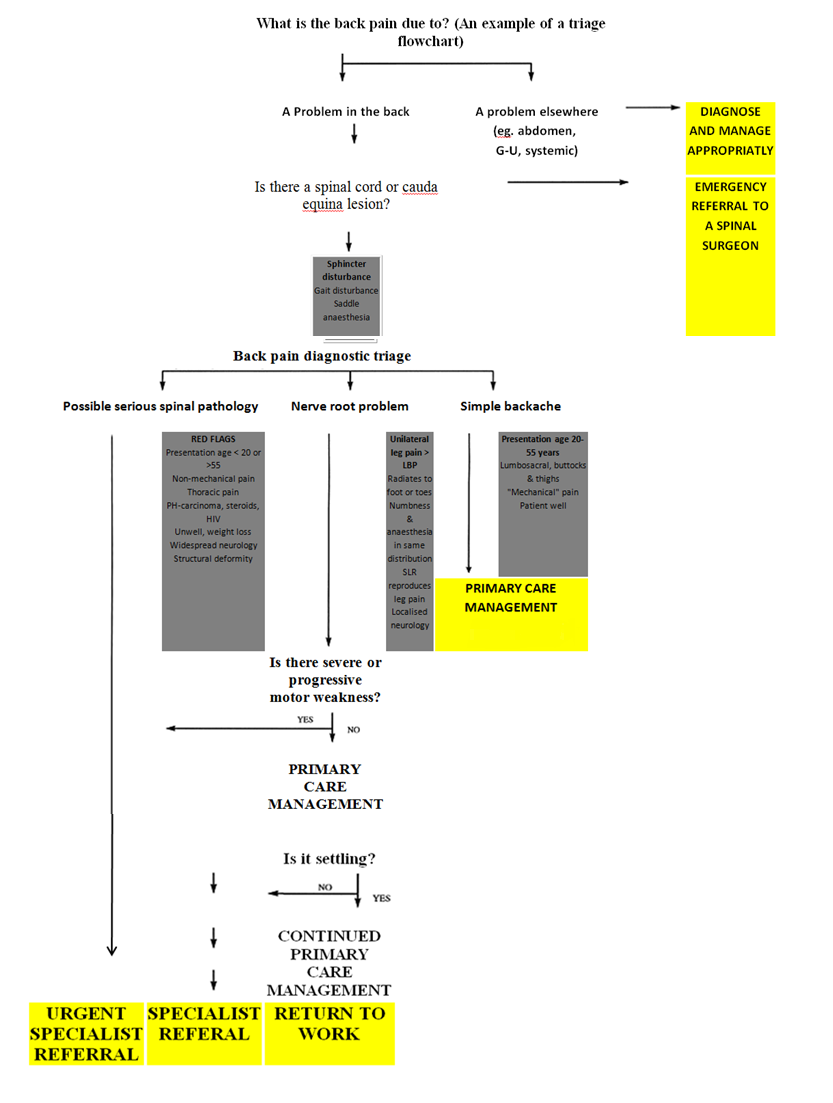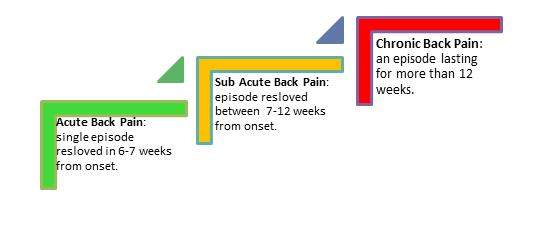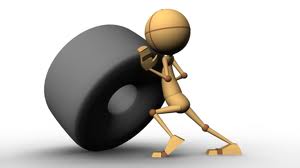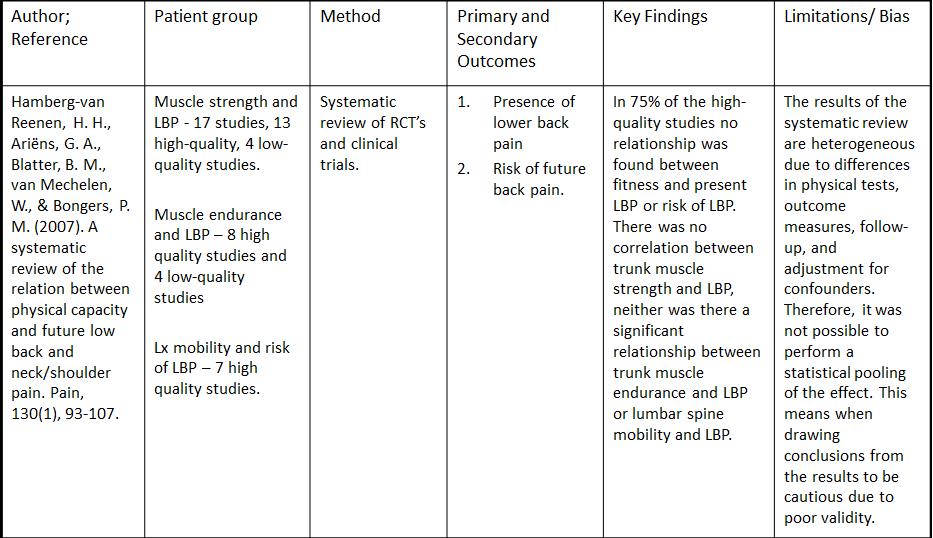Fitness and Low Back Pain: Difference between revisions
George Smith (talk | contribs) No edit summary |
George Smith (talk | contribs) No edit summary |
||
| Line 70: | Line 70: | ||
= Measures of back strength = | = Measures of back strength = | ||
<br>There are a variety of measures targeted at assessing muscular strength e.g. one rep max, isokinetic dynamometry, manual muscle testing etc. | <br>There are a variety of measures targeted at assessing muscular strength e.g. one rep max, isokinetic dynamometry, manual muscle testing etc. | ||
<br>Muscle strength with regards to the lower back is commonly researched as a proxy measure of ‘physical capacity’ which also includes muscle endurance and joint mobility (Hamberg-van Reenen et al 2007) although there is a lack of sufficient high quality evidence surrounding reproducibility of current physical capacity measures in healthy subjects and in patient groups. (Essendrop et al 2002). | <br>Muscle strength with regards to the lower back is commonly researched as a proxy measure of ‘physical capacity’ which also includes muscle endurance and joint mobility (Hamberg-van Reenen et al 2007) although there is a lack of sufficient high quality evidence surrounding reproducibility of current physical capacity measures in healthy subjects and in patient groups. (Essendrop et al 2002). | ||
<br> | |||
[[Image:Strength_image.jpg|center]]<br> | |||
<br>When researching lower back strength in relation to prevalence of LBP isokinetic maximal flexion and extension calculated with an isokinetic dynamometer, isoinertial dynamic testing and isokinetic lifting force are commonly used (Takala et al 2000) There is some evidence to show that isokinetic measurement is reproducible and valid (Dvir et al 2001)<br> | <br>When researching lower back strength in relation to prevalence of LBP isokinetic maximal flexion and extension calculated with an isokinetic dynamometer, isoinertial dynamic testing and isokinetic lifting force are commonly used (Takala et al 2000) There is some evidence to show that isokinetic measurement is reproducible and valid (Dvir et al 2001)<br> | ||
{{#ev:youtube|http://xEhLr5y0wBE}} | |||
= Evidence review = | = Evidence review = | ||
Revision as of 15:05, 15 January 2014
Original Editor - Peter Copeland, George Smith, Bryn Roberts as part of the Nottingham University Spinal Rehabilitation Project
Top Contributors - Peter Copeland, George Smith, Lucinda hampton, Bryn Roberts, Kim Jackson, Laura Ritchie, Evan Thomas, 127.0.0.1, WikiSysop, Wanda van Niekerk, Admin, Shaimaa Eldib, Aminat Abolade and Fahad Bin Aftab
Defining Low Back Pain (LBP)[edit | edit source]
• Low back pain is an umbrella of conditions with 80% of adults estimated to experience LBP at some point during their life (Palmer et al)
• Male and female individuals are affected equally (Helliovaara, 1989).
• Low back pain encompasses and pain between the bottom of the ribs and the buttock crease.
• Common subdivisions of LBP are acute, sub-acute or chronic/persistent and specific or non-specific
• The three most common diagnostic methods are (in no particular order) Maitland, McKenzie and a movement based assessment.
• Low back pain guidelines
Specific vs Non-specific[edit | edit source]
Specific low back pain refers to the diagnosis of a specific cause/structure such as a malignancy, fracture, or disk bulge etc. Specific low back pain should be identified with appropriate triage and the appropriate investigations undertaking. (Red Flags in spinal cases).
Non-specific low back pain is much more common and evidence suggests it accounts for approx. 95% of back pain, (CSAG 1994)
Acute/Sub-acute and Chronic Low Back Pain[edit | edit source]
Alongside specific and non-specific, back pain is also defined by its duration. (See figure 1)
Figure 1: Time scales in non-specific low back pain for first episode: Hayden et al 2005
Fitness[edit | edit source]
Physical fitness is a set of attributes that people have or achieve. Being physically fit has been defined as:- the ability to carry out daily tasks with vigour and alertness, without undue fatigue and with ample energy to enjoy leisure-time pursuits and meet unforeseen emergencies (President's Council on Physical Fitness and Sports, 1971)
In accordance with Hales in 2010, these are the five components of physical fitness:-
1) Cardiorespiratory Endurance
2) Muscular Endurance
3) Muscular Strength
4) Body Composition
5) Flexibility
Cardiovascular Endurance –[edit | edit source]
this is the ability of the circulatory and respiratory systems to supply fuel during sustained physical activity and eliminate fatigue products after supplying fuel. The association between cardiovascular fitness and LBP is not as discernible as that seen with muscular weakness, reduced flexibility and reduced muscular endurance. The pain relieving mechanics of aerobic exercise on lower back pain are not clear, since the intensity of the muscular contractions are not intense enough to promote muscular hypertrophy. Cardiovascular fitness may help prevent any unfavourable adaptations to the body associated with neuromuscular health, muscular endurance, muscular strength and general loading through the lumbar spine. Also, due to the avascular nature of the intervertebral discs, by the age of maturation, to maintain healthy they rely on osmosis for nutrition and in accordance with Plowman, 1992, an efficient circulatory system has been found to increase the transport of nutrients and unwanted waste products to and from the discs.
Plowman, S. A. (1992). Physical activity, physical fitness, and low back pain. In J. O. Holloszy (Eds.), Exercise and Sport Sciences Reviews (pp. 221-242). Baltimore: Williams & Wilkins.
Flexibility[edit | edit source]
is the range of movement available a particular joint of the body. Patients presenting with low back pain often display significant reductions in the degree of several movements at the pelvis and trunk. Adequate flexibility of the lumbar spine enhances functional mechanical advantage, while spasmodic or shortened back muscles adversely affect spinal mechanics (Farfan, 1975). Tightness in the hip flexors can reduce pelvic mobility and therefore put excess strain on the lumbar spine during certain disciplines of movement – especially into flexion, following that tight hamstring and hip extensors can also contribute to a reduce in the lordotic curve, which can potentially effect spinal loading mechanisms and lead to injury. However, the relationship between flexibility and lower back pain is still largely based around theory and there are yet to be a number of high quality experiments/investigations to either support or refute this hypothesis.
Farfan, H. F. (1975). Muscular mechanism of the lumbar spine and the position of power and efficacy. Orthopaedic Clinics of North American, 6, 135-144.
Muscular Endurance[edit | edit source]
is the ability of the muscle to exert a submaximal force repeatedly over a sustained period of time. In a study conducted by Biering-Sorenson in 1984, it was discovered that patients with low back pain had reduced levels of muscular endurance in the lumbar extensors in comparison with non-sufferers. It has been Studies have also reported that abdominal muscular endurance in low back pain sufferers is significantly decreased in contrast to those in the normal health population (Foster & Fulton, 1991).
Biering-Sorenson, F. (1984). Physical measurements as risk indicators for low back trouble over a one-year period. Spine, 9, 106-119.
Foster, D. N., & Fulton, M. N. (1991). Back pain and the exercise prescription. Clinics in Sports Medicine, 10, 187-209
Muscular Strength[edit | edit source]
is the ability to exert a maximal force against a resistance. Several arguments can be made to suggest that this component of fitness has a large roll to play in low back pain. This is discussed further down the page
Addison, R. (1980). Trunk strength in patients seeking hospitalization for chronic low-back disorders. Spine, 5, 539-544.
Kravitz, L., & Andrews, R. (1995). Fitness & the low back. IDEA Today, 13(4), 44-52.
Body Composition [edit | edit source]
is the relative amounts of muscle, fat, bone and other vital parts of the body. The most related aspect of body composition to prevalence of low back is undoubtedly fat content/obesity. Numerous studies have been conducted highlighting the relationship between increased fat content and the likelihood/prevalence of lower back pain. A study conducted Bener et al in 2003 found that there was a moderate positive relationship between obesity and lower back pain, however the results were based on the BMI calculation which does not definitively measure body fat content. In a study conducted by Urquhart 2011, it was also evident that there was a relationship between obesity and lower back pain. The difference with this study however is that not only was the BMI calculation used as a measure of obesity but Lean Fat Mass and Lean Muscle Mass was also calculated to determine whether it was fat content or general increase weight that was directly proportional to the potential for LBP. It is the common belief that an increase in body weight alters spinal biomechanics and loading creating excess strain to be put through certain structures. The theory behind back pain was less prevalent in those with high lean muscle mass was that the increase muscle mass was there to compensate for the excess spinal loading and therefore would not alter loading mechanics. The studies conducted however have all been cross-sectional studies and longitudinal studies will need to be completed to assess if a higher fat mass predisposes the development of lower back pain later in life.
Bener, A., Alwash, R., Gaber, T. and Lovasz,G. 2003. Obesity and Low Back Pain. Coll. Antropol. 27 (2003) 1: 95–104
Urquhart, D.M. 2011, Higher Body Fat Linked to Increased Back Pain. Spine 9/1/2011 Edition. Lippincott Williams and Wilkins, Philadelphia.
Strength and Low Back pain[edit | edit source]
Muscle strength is the contractile force a muscle is able to produce.
Measures of back strength[edit | edit source]
There are a variety of measures targeted at assessing muscular strength e.g. one rep max, isokinetic dynamometry, manual muscle testing etc.
Muscle strength with regards to the lower back is commonly researched as a proxy measure of ‘physical capacity’ which also includes muscle endurance and joint mobility (Hamberg-van Reenen et al 2007) although there is a lack of sufficient high quality evidence surrounding reproducibility of current physical capacity measures in healthy subjects and in patient groups. (Essendrop et al 2002).
When researching lower back strength in relation to prevalence of LBP isokinetic maximal flexion and extension calculated with an isokinetic dynamometer, isoinertial dynamic testing and isokinetic lifting force are commonly used (Takala et al 2000) There is some evidence to show that isokinetic measurement is reproducible and valid (Dvir et al 2001)
Evidence review[edit | edit source]
A systematic review from 2007 (Hamberg-van Reenen et al) evaluated evidence on the relationship between physical capacity and future low back and neck/shoulder pain. It was the first systematic review of longitudinal studies assessing the link between physical capacity and LBP.
Thirteen high quality studies reported no association between trunk muscle strength and future risk of low back pain. The risk ratios were insignificant between low and high isometric strength (0.6 and 1.2 respectively), however five high quality studies have shown that poor trunk muscle strength is a significant predictor of LBP and two other high quality studies found high strength as a risk factor. The results of this systematic review therefore are inconclusive one way or another in terms of the relationship between trunk strength and LBP.
A more recent study looking into LBP in male adolescents found isometric and isoinertial trunk performance was not significantly associated with LBP although they did find that regular sport participation was associated with LBP (93.9%:67.9% LBP + sport: No LBP + sport) Balague et al 2010. The review is further summaried in the table below.
Another paper by Lee et al 2012 evaluating the strength and cross sectional area of extensor muscles in chronic LBP patients states that ‘weakness of the back muscles can lead to LBP’. The evidence this paper has used to support their own research actually contradicts the basis of their paper and is highlighted here as a good example of low quality research in the area.
Clinical Relevence[edit | edit source]
The research is inconclusive with regards to strength and low back pain however there is good evidence that poor trunk muscle strength is a risk factor for LBP. The evidence has so far failed to establish causality. Clinical guidance e.g. NICE guidelines still recommend strength exercise as part of a rehab program for BP.
Bottom Line[edit | edit source]
An argument can be made for or against using strengthening exercises and more research is needed to determine if either low or high strength is a risk factor for LBP.
[edit | edit source]
Sub Heading 2[edit | edit source]
Sub Heading 3[edit | edit source]
Recent Related Research (from Pubmed)[edit | edit source]
Extension:RSS -- Error: Not a valid URL: Feed goes here!!|charset=UTF-8|short|max=10
References[edit | edit source]
References will automatically be added here, see adding references tutorial.










